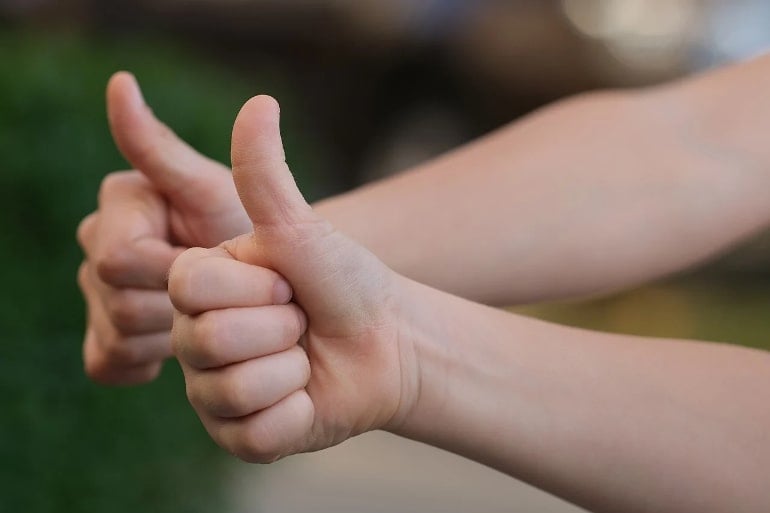Summary: A new study sheds light on why humans often use hand movements while talking. Researchers report rhythmic hand gestures affect rib cage movements, leading to a change in lung volume and ultimately aspects of the voice. Infants connect early vocal babbling with hand gestures, demonstrating an early connection between movement and vocal production.
Source: GWZ
Researchers from Radboud University and ZAS Berlin have developed a new perspective on why humans often move their hands rhythmically during speaking.
The perspective published in Neuroscience and Biobehavioral Reviews, suggests that there are striking connections between animal and human behavior when it comes to moving with sounds.
For example, flying bats synchronize their echo-locating vocalization and their wingbeats which can be directly related to how humans synchronize acoustic features of their voice and move their upper limbs.
“When a bat echo-locates while flying, the muscle tensioning that drive the wingbeats also leads to small compressions of the lungs. It becomes more economical for the bat to vocalize during these particular moments of the wingbeat cycle, leading to synchronization,” says researcher Wim Pouw at the Donders Center for Brain, Cognition, and Behavior.
Pouw and his collaborator, Susanne Fuchs from Leibniz-Center General Linguistics (ZAS) suggest that this is comparable to what happens when humans produce rhythmic hand gestures, as another line of research has shown that these hand gestures affect rib cage movements, which slightly change the volume of the lungs, and thereby change aspects of the voice.
“Once we started reading up on very different lines of research, we were astonished how prevalent it is for animals to time their vocalizations together with movements. We discovered that coupling movement and vocalization might be very important for the development of vocal repertoires,” Dr. Fuchs says.
In a particular kind of bird, for example, flightless chicklets have a very typical vocalization. But the vocalization quality drastically changes when the chicklets start using their wings in the nest to practice flying. Vocalization becomes similar to adult vocalizations when they start using their wings for flight.

“This is exactly what is found in human infants around nine months of age,” Pouw says. “When infants start to rhythmically ‘babble’ with their hands in an exploratory fashion, they also start to ‘babble’ in speech in the form of reduplicated syllables such as ‘mama’ or ‘papa.'” Rhythmic movements may thus have very early connections with the voice, which explains why movement and sounds are so fundamentally related.
This new perspective of how gesture relates to the voice via interactions with respiration provides an answer to why humans started to move their hands while vocalizing and speaking: These systems physically interacted throughout evolution, and this development is in a way mirrored by infants who start to learn to move and vocalize at the same time.
“Many researchers of communication believe that manual gestures were for showing things,” Pouw says. “But we actually think this not the whole story… in a way gestures are also part of what it means for humans to speak, which is not a passive affair, but an orchestra of movement to generate meaning.”
About this neuroscience research news
Author: Fabienne Salfner
Source: GWZ
Contact: Fabienne Salfner – GWZ
Image: The image is in the public domain
Original Research: Open access.
“Origins of vocal-entangled gesture” by Wim Pouw et al. Neuroscience and Biobehavioral Reviews
Abstract
Origins of vocal-entangled gesture
Gestures during speaking are typically understood in a representational framework: they represent absent or distal states of affairs by means of pointing, resemblance, or symbolic replacement. However, humans also gesture along with the rhythm of speaking, which is amenable to a non-representational perspective.
Such a perspective centers on the phenomenon of vocal-entangled gestures and builds on evidence showing that when an upper limb with a certain mass decelerates/accelerates sufficiently, it yields impulses on the body that cascade in various ways into the respiratory–vocal system. It entails a physical entanglement between body motions, respiration, and vocal activities. It is shown that vocal-entangled gestures are realized in infant vocal–motor babbling before any representational use of gesture develops.
Similarly, an overview is given of vocal-entangled processes in non-human animals. They can frequently be found in rats, bats, birds, and a range of other species that developed even earlier in the phylogenetic tree.
Thus, the origins of human gesture lie in biomechanics, emerging early in ontogeny and running deep in phylogeny.






